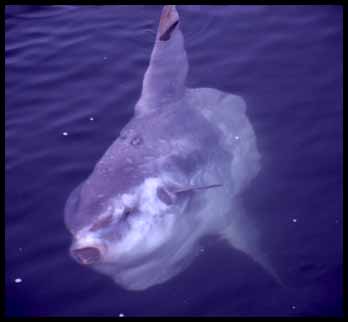
September 19, 2009
Can you tell the difference between the ocean sunfish images and the marine-going crocodiles pictured on this page?
If we are to believe officials in the Cayman Islands, local eyewitnesses who are reporting crocodiles are badly mistaken. They are merely seeing sunfish, say the officials.
According to the Cayman News Services, the reported sighting of a pair of crocodiles swimming off Seven Mile Beach on September 18, 2009, could well have been two harmless ocean sunfish (like the one pictured above) that the Department of Environment (DoE) found offshore of the governor’s residence. However, the DoE said officers will continue to investigate reported sightings of a crocodile in the vicinity of the Sundowner and White Sands condominiums as crocodiles do occasionally appear in the waters off the Cayman Islands. Crocodile sighting were also reported on September 17th.
“After receiving a call this morning about another crocodile sighting on Seven Mile Beach, Chief Conservation Officer Mark Orr immediately checked out the details. However, on entering the water, he found two sunfish,” said DoE Director Gina Ebanks-Petrie.
“A previous report of a crocodile in July this year off Seven Mile Beach was also later confirmed as a sunfish,” she said. “Two types of crocodiles are naturally found in the north-western Caribbean, namely the American and Cuban crocodile.
The American crocodile (Crocodylus acutus) has a wide range and can be found in Cuba, Jamaica, Mexico and the Southern States. The Cuban crocodile (Crocodylus rhombifer) is only found in south-western Cuba. However, skeletal remains found locally indicate that historically both species were naturally present in the Cayman Islands.
“Many crocodiles have a ‘wandering’ phase, in which young animals range far and wide in search of new habitat. The Cayman Islands falls within the natural range of both these species, therefore we should not be surprised at an occasional appearance off our shores,” Mrs. Ebanks-Petrie explained.
In Florida, some 500 – 1,200 American crocodiles thrive in the wild. To date there have been no recorded attacks by this species on humans in the United States where they are a protected species. In other countries, in most cases, when attacks by American Crocodiles do occur, the attack is directed towards a person who is trying to catch or harass the crocodile.
“For this reason, the DoE is adhering to the Florida Guidelines for dealing with American crocodiles. These recommend that when wandering individuals are located, they be left alone and not harassed. In most cases, they do move on, naturally and of their own accord,” she said.
So, did you correctly identify the right species in the photos above?
∆∆∆∆∆∆∆∆∆∆∆∆∆∆∆∆∆∆
Support the new, openly public, physical location of the International Cryptozoology Museum in downtown Portland, Maine. Joins us in this great adventure.
Please click on the button below (not the one up top) to take you to PayPal to send in your museum donation.
If you wish to send in your donation via the mails, by way of an international money order or, for the USA, via a check or money order, please use this snail mail address:
Loren Coleman
International Cryptozoology Museum
PO Box 360
Portland, ME 04112
Thank you, and come visit the museum at 661 Congress Street, Portland, Maine 04101, beginning November 1, 2009!!
About Loren Coleman
Loren Coleman is one of the world’s leading cryptozoologists, some say “the” leading living cryptozoologist. Certainly, he is acknowledged as the current living American researcher and writer who has most popularized cryptozoology in the late 20th and early 21st centuries.
Starting his fieldwork and investigations in 1960, after traveling and trekking extensively in pursuit of cryptozoological mysteries, Coleman began writing to share his experiences in 1969. An honorary member of Ivan T. Sanderson’s Society for the Investigation of the Unexplained in the 1970s, Coleman has been bestowed with similar honorary memberships of the North Idaho College Cryptozoology Club in 1983, and in subsequent years, that of the British Columbia Scientific Cryptozoology Club, CryptoSafari International, and other international organizations. He was also a Life Member and Benefactor of the International Society of Cryptozoology (now-defunct).
Loren Coleman’s daily blog, as a member of the Cryptomundo Team, served as an ongoing avenue of communication for the ever-growing body of cryptozoo news from 2005 through 2013. He returned as an infrequent contributor beginning Halloween week of 2015.
Coleman is the founder in 2003, and current director of the International Cryptozoology Museum in Portland, Maine.
Filed under Breaking News, Crazy Crocs, Cryptotourism, CryptoZoo News, Eyewitness Accounts, Out of Place, Weird Animal News